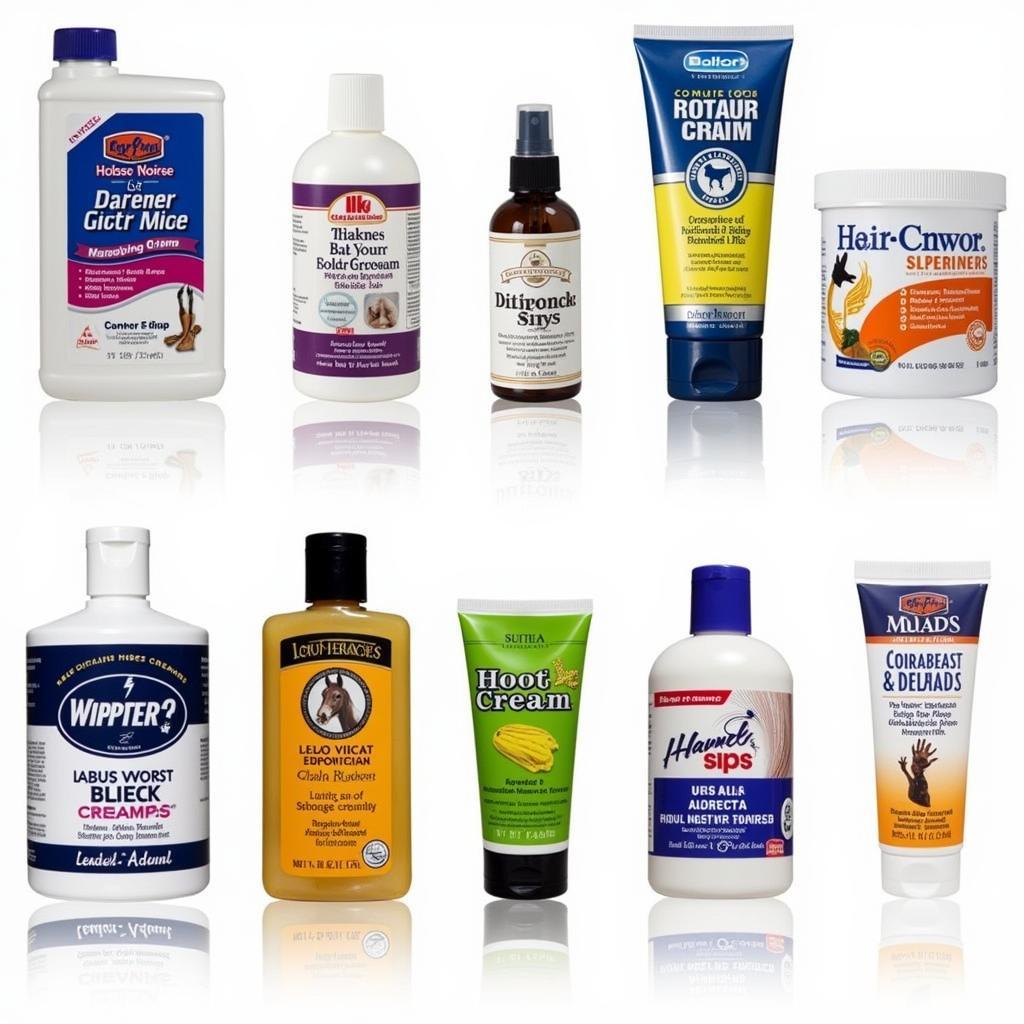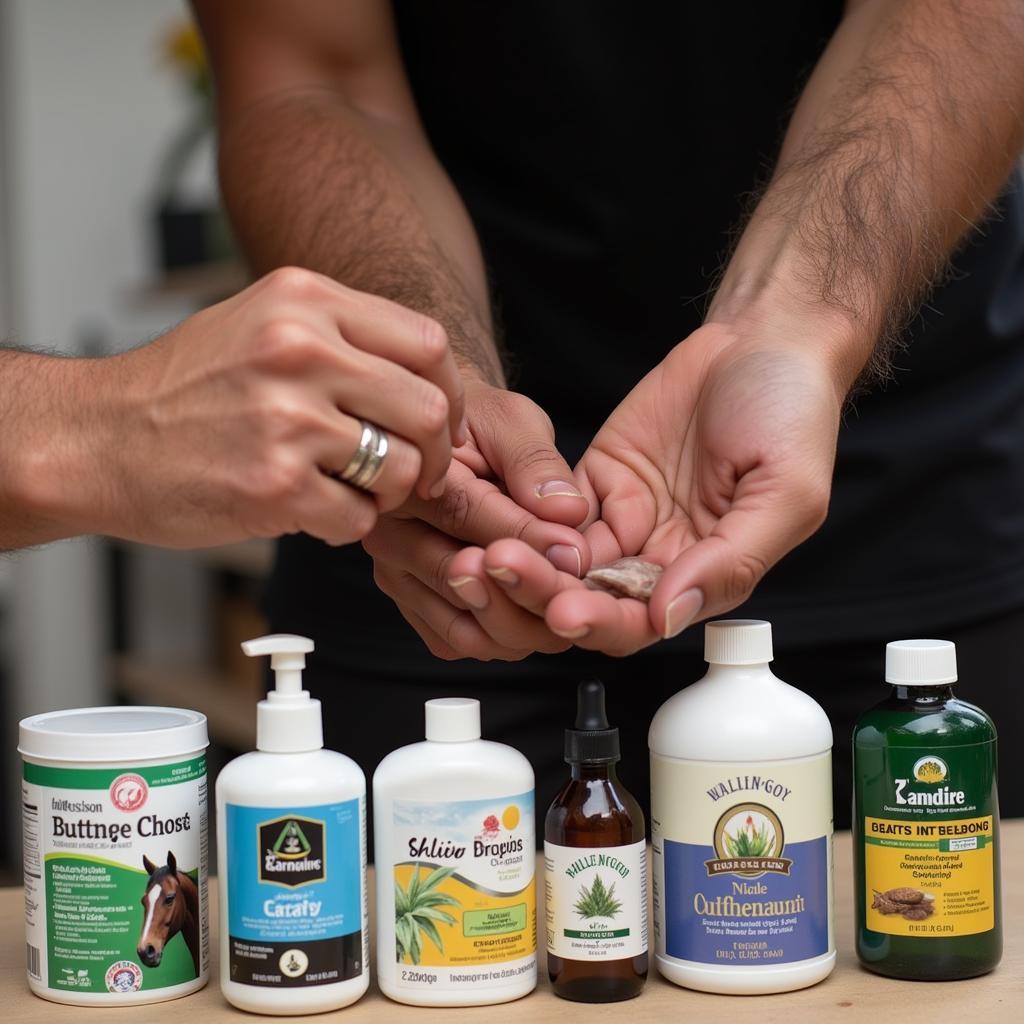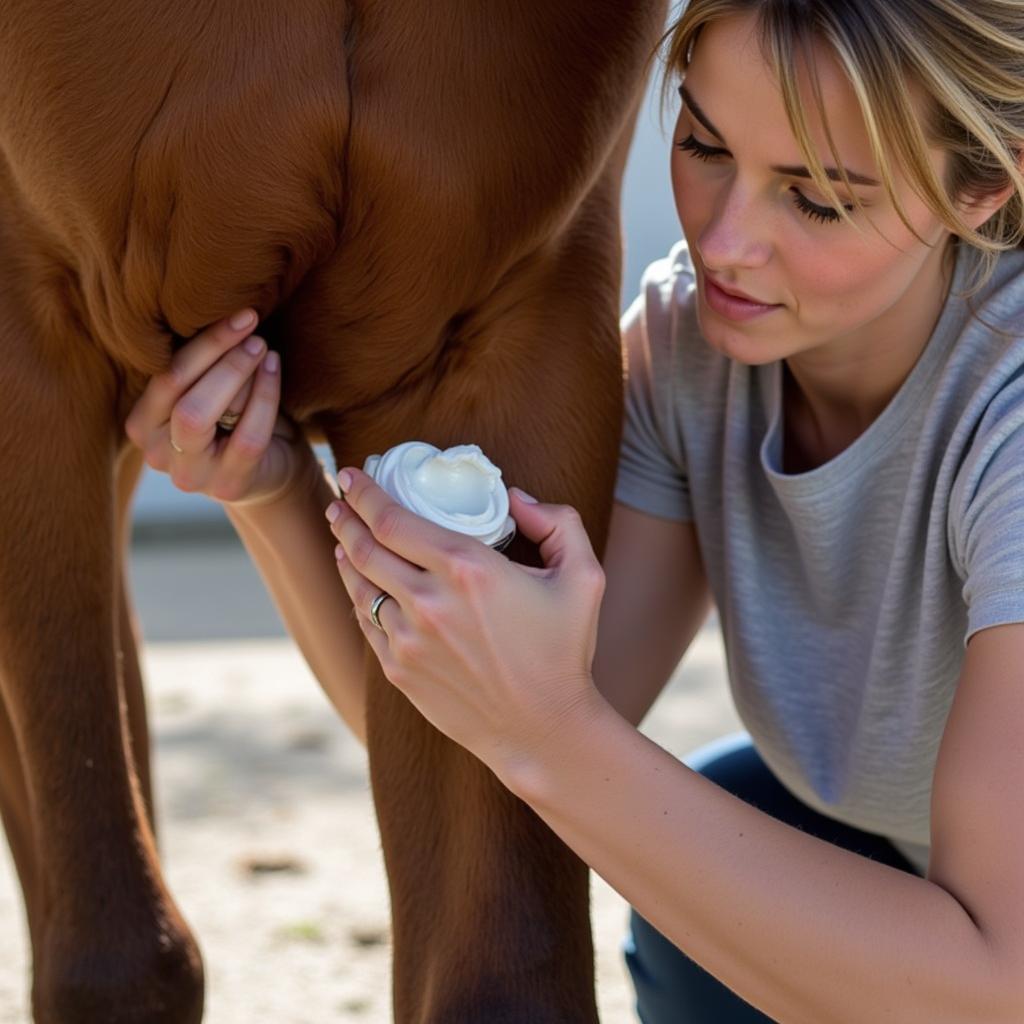Creams play a vital role in equine care, addressing a range of skin and hoof issues. From soothing irritated skin to protecting against harsh weather, the right cream can be a horse owner’s best friend. But with a plethora of options available, navigating the world of Cream For Horses can feel overwhelming. This comprehensive guide will equip you with the knowledge to choose the best cream for your equine companion’s needs.
Understanding the Different Types of Cream for Horses
 Types of Horse Cream: Tubes and tubs of various creams for horses.
Types of Horse Cream: Tubes and tubs of various creams for horses.
Just like humans, horses benefit from specialized skincare. Let’s delve into the common types of horse creams and their uses:
- Medicated Creams: These address specific conditions like rain rot, ringworm, or sweet itch. Always consult your veterinarian for diagnosis and treatment recommendations.
- Barrier Creams: Creating a protective layer against moisture and irritants, these creams are crucial for preventing mud fever and skin infections, especially during wet seasons.
- Hoof Creams: Essential for maintaining hoof health, these creams come in various formulations to moisturize, harden, or treat thrush.
- Coat Conditioners & Shine Sprays: For a polished look, these products enhance your horse’s coat, adding shine and reducing tangles.
Choosing the Right Cream for Your Horse
 Choosing the right horse cream: A person carefully examining a horse's skin.
Choosing the right horse cream: A person carefully examining a horse's skin.
Selecting the appropriate cream for your horse hinges on several factors:
- Skin Condition: Identify the specific issue – dry skin, wounds, fungal infection, or insect bites – to choose a cream with targeted action.
- Ingredients: Opt for natural, horse-safe ingredients and avoid potentially harmful chemicals.
- Sensitivity: Horses with sensitive skin require hypoallergenic and fragrance-free formulas. Patch testing a small area is always recommended.
- Seasonality: Heavy creams offer protection during harsh winters, while lighter, breathable formulas are suitable for warmer months.
Applying Cream for Horses: Tips and Best Practices
 Applying cream to a horse: Gentle application of cream on a horse's leg.
Applying cream to a horse: Gentle application of cream on a horse's leg.
Proper application ensures optimal effectiveness and safety:
- Cleanliness: Thoroughly clean the area with mild soap and water before applying any cream.
- Dryness: Ensure the skin or hoof is completely dry before application to prevent trapping moisture and fostering bacterial growth.
- Gentle Application: Use clean hands or a soft cloth to apply the cream evenly, avoiding excessive rubbing.
- Storage: Store creams as directed on the label, typically in a cool, dry place away from direct sunlight.
Common Mistakes to Avoid
- Ignoring Underlying Issues: Creams address symptoms, but underlying health conditions may require veterinary attention.
- Over-Application: Using more cream doesn’t guarantee better results and can clog pores, leading to further irritation.
- Inconsistent Use: For optimal results, follow the recommended frequency and duration of application.
Cream for Horses: A Vital Part of Equine Wellness
Choosing the right cream for horses is about more than just aesthetics. It’s an investment in your horse’s overall health and well-being. By understanding your horse’s needs and the diverse range of creams available, you can contribute to their comfort and vitality.
Remember, a well-informed horse owner is a responsible horse owner. If you’re ever unsure about which cream is right for your horse, don’t hesitate to consult with your veterinarian or a trusted equine professional.
FAQs about Cream for Horses
Can I use human cream on my horse?
While it might be tempting, it’s generally not recommended. Human skin has different pH levels and sensitivities compared to horses. Always opt for creams specifically formulated for equine use.
How often should I apply cream on my horse?
The frequency depends on the product and your horse’s needs. Always follow the manufacturer’s instructions for optimal results.
What are some natural ingredients to look for in horse creams?
Aloe vera, shea butter, coconut oil, and beeswax are known for their soothing and moisturizing properties.
My horse has a reaction to a new cream. What should I do?
Discontinue use immediately and consult your veterinarian. They can help identify the ingredient causing the reaction and recommend alternatives.
Where can I buy quality cream for my horse?
You can find a variety of horse creams at reputable tack shops, online retailers specializing in equine supplies, and sometimes even at your veterinarian’s office.
Need more gift ideas for your equestrian friends? Check out our curated list of Christmas ideas for horse lovers.
For a comprehensive guide to horse hoof care, explore our article on cream for horses hooves.
Need to stock up on essential horse care products? Browse our selection of things to buy for horses.
For specific hoof concerns, learn more about turpentine for horses hooves.
Discover the benefits of swat ointment for horses in our detailed guide.
When in doubt about your horse’s skin or hoof health, always consult a veterinarian. They can provide personalized advice and treatment plans.
Need expert advice on choosing the right cream for your horse? Contact us! Phone: 0772127271, Email: [email protected] Or visit us at: QGM2+WX2, Vị Trung, Vị Thuỷ, Hậu Giang, Việt Nam. Our dedicated customer support team is available 24/7 to assist you.